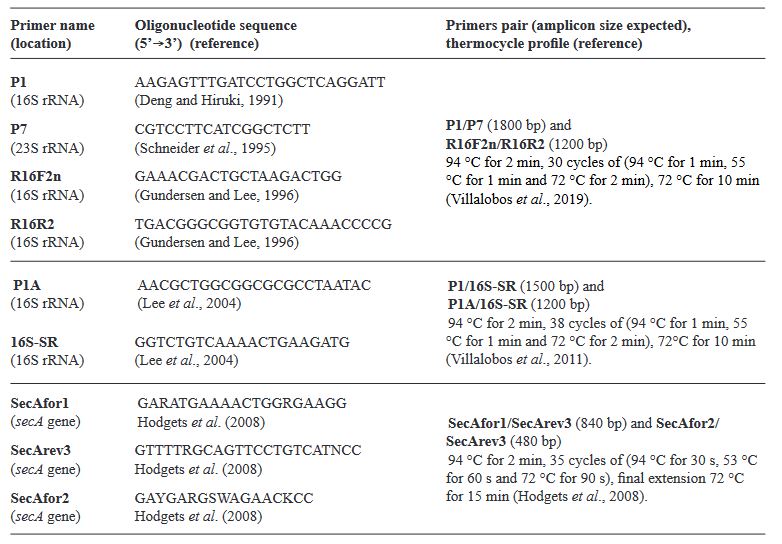Bocconia frutescens little leaf, a new plant disease associated to a ´Candidatus Phytoplasma pruni´ related strain in Costa Rica
By
William Villalobos Muller,
Laura Garita Salazar,
Ana María Conejo Salazar,
Izayana Sandoval Carvajal,
Mauricio Montero Astúa,
Lisela Moreira Carmona*
* Corresponding Author. Email: / Institution: Universidad de Costa Rica
Received: 05/March/2024 – Published: 20/June/2024 – DOI: https://doi.org/10.18781/R.MEX.FIT.2403-1
Abstract Background/Objective. Bocconia frutescens (Papaveraceae) is a small tree distributed naturally from Mexico to Argentina and the Caribbean Bassin. Bocconia trees showing symptoms resembling phytoplasmas infection, such as little leaves and witches´-broom, were found in Cartago province, Costa Rica. Detection and identification of the potential phytoplasmas associated with B. frutescens little leaf symptoms was the objective out of this study.
Materials and Methods. Evaluation of leaves tissue using transmission electron microscopy (TEM), nested PCR using universal and specific primers to amplify phytoplasmas 16S rRNA and secA genes. Nucleotidic sequences (Sanger method) were obtained from amplicons, and used for BLASTn, phylogenetic analyses, and in silico RFLP’s.
Results. Presence of phytoplasmas into phloem tissue, only in symptomatic trees, was evidenced by TEM. Comparison of partial sequences (16Sr and secA genes) by BLASTn, in silico RFLPs and phylogenetic analyses, showed the occurrence of a Candidatus Phytoplasma pruni related strain in the samples evaluated.
Conclusion. Phytoplasmas were found only in the symptomatic B. frutescens trees evaluated. The phytoplasmas were identified as a Ca. Phytoplasma pruni related strain. This is the first report of B. frutescens as a natural host of Ca. Phytoplasma pruni.
Keywords:
Papaveraceae, semi-nested PCR, in silico RFLP’s, 16SrIII-F, secA

Figure 1. Bocconia frutescens (Papaveraceae) trees showing symptoms reminiscent of phytoplasmas infection, observed in Cartago province, Costa Rica; A) witches’-broom and bunches of little leaves observed in some branches; B) Witches’- broom, defoliation, and die-back; C) Detail of axillar proliferation with leaves reduced in size.

Figure 2. (A) Pleomorphic phytoplasmas bodies (») found inside phloem of Bocconia frutescens trees with little leaves and witches’ broom symptoms observed in Cartago province, Costa Rica. CW = cell wall. (B and C) Profiles of virtual RFLPs obtained at iPhyClassifier to 16Sr F2/R2n fragment of phytoplasmas associated to B. frutescens little leaf (BfLL, GenBank Acc. No. PP353584) using BstUI (C) and HpaII (D). Molecular weight (MW) fragment sizes (bp): 1353, 1078, 872, 603, 310, 281, 271, 234, 194, 118, 72

Figure 3. Dendrogram obtained from phylogenetic analysis using Maximum Parsimony method of partial 16S rRNA gene sequences from Bocconia frutescens little leaf (BfLL) phytoplasma, 29 sequences of 16SrIII group´s strains, seven ‘Ca. Phytoplasma species´ and Acholeplasma laidlawii as outgroup. The bootstrap test selected was 1000 replicates. GenBank accession number of every sequence is shown in parentheses. BfLL phytoplasma is displayed in bold. * = tentatively new subgroups

Figure 4. Dendrogram obtained from phylogenetic analysis with Maximum Parsimony using partial secA gene sequences from Bocconia frutescens little leaf associated phytoplasma, ten sequences of secA from different 16SrIII subgroups, ‘Ca. Phytoplasma trifolii´ and Bacilus subtilis (outgroup). The bootstrap test selected was 1000 replicates. GenBank accession number of every sequence is shown in parentheses. * = tentatively new subgroup.

Table 1. Localities at Cartago province, Costa Rica, where trees of Bocconia frutescens were observed with little leaf symptoms associated with phytoplasmas.

Table 2. Data about oligonucleotides (primers) and thermocycle profiles herein used for the detection of phytoplasmas genes 16S rRNA and secA translocase gene.

Table 3. Unique oligonucleotide sequence regions (UOSR) in the 16S rRNA gene of ‘Candidatus Phytoplasma pruni’ rrnA (JQ044393, Davis et al., 2013) compared to 16Sr sequence of BfLL associated phytoplasma (PP353584). Position in the respective sequence is shown in parenthesis, every nucleotide corresponding to a SNP is displayed in standard DNA nucleotides color, bold font and underlined.

